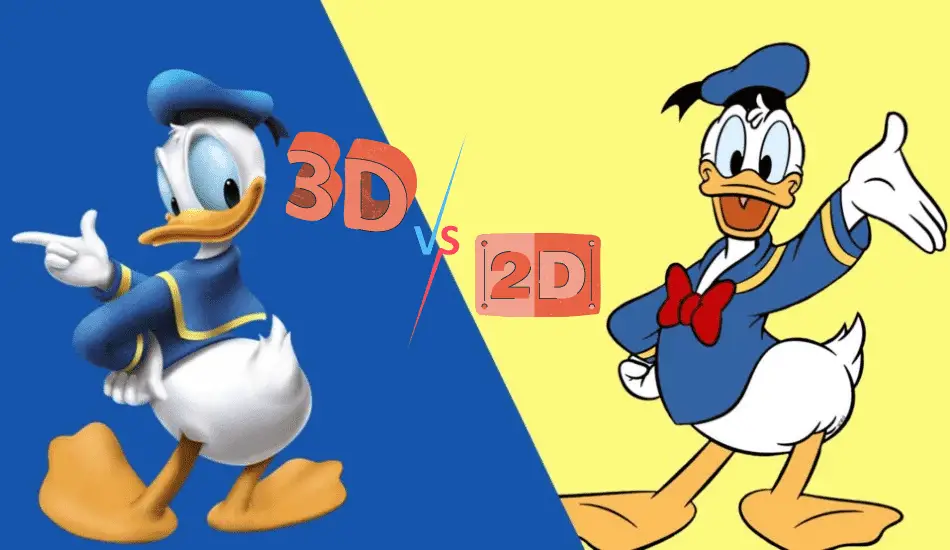It’s time to unleash something! And, trust me, it’s a big thing! There has been a hot debate among mass people on 2D and 3D for an extended period. Moreover, there’s also so much confusion regarding this topic.
But, we assure you today we’ll clear up all the doubts surrounding them. Are you a moviegoer or video game lover? Then, both of the terms should be familiar to you. Hence, the debate between 2D Vs. 3D is not new.
The terms 2D and 3D stand for two-dimensional and three-dimensional accordingly. What does that mean? It means that the object is situated in two or three dimensions. Further, four, five, six, seven, nine, eleven, and so on exist. Now, we’re going to discuss 2D Vs. 3D – the ultimate differences between 2D and 3D.
Here we go –
2D Vs. 3D – Here’s the Difference Between 2D Vs. 3D
Before uncovering the differences between 2D Vs. 3D – we have to learn what 2D and 3D are? This is how you can find out the differences more conveniently.
What is 2D?
A 2D or two-dimensional structure is a shape or object that stays in two dimensions. It basically exists in two axes – the X-axis and Y-axis. This is how the structure of 2D gets shaped. Besides, this is just a usual assumption of 2D. To know it better, you must understand what “dimension” is. This is the main criteria to get acknowledged in 2D or 3D.
Dimension is just a measurement. It can be height, length, etc. In any image or object that has been created using them, they will appear two-dimensional in the human eyes.
2D shapes become visible flat and their shape also lies on flat ground. Due to the flat characteristic, 2D shapes are also widely known as plane figures or plane shapes. Additionally, 2D shapes don’t possess a volume at all.
Some examples of 2D shapes are – flat TV, sheets, wall stickers, square, pentagons, etc.
Characteristics of 2D Shapes
- Their appearance is flat
- Due to their bounded shape, they don’t have any volume
- These objects generally stand within the borderline of the X and Y-axis
- 2D shapes have a beginning and end point
Pros of 2D:
- Reasonable cost to produce
- Take a little time to assemble
- The software doesn’t drain frequently
Cons of 2D:
- Not that dynamic and realistic
- People are avoiding it due to a lack of advancement
What is 3D?
The 3D is a three-dimensional object or shape that contains three dimensions. Besides, it survives in three planes or axes. They are – x-axis, y-axis, and z-axis. All these three axes define its dimensions. Unlike 2D, 3D is not restricted. Apart from the height and length, it has an extended new dimension known as the Z-axis.
This extra axis helps to deter the height of the figure. It’s easy to surmise that any object that contains length and width along with height has three measurements. As a result, they’re three-dimensional. Since they don’t have any bound like 2D, they are not flat or plane.
Furthermore, they also have volume, unlike their counterparts. In our naked eyes, they be evident as solid and sturdy instead of flat.
Some solid examples of 3D are – prisms, pyramids, human beings, cylinders, etc.
Characteristics of 3D Shapes
- It stands on three axes – X, Y, and Z-axis
- A 3D figure consists of height, length, and width
- They have volume
- They aren’t flat or plane
Pros of 3D:
- The movement of 3D is superb and you can rotate 3D videos or animation without needing to redraw each frame
- They are extremely realistic
- You can do various tricky things in 3D quite easily
- The popularity of this version is increasing fast
Cons of 3D:
- Very complicated
- Expensive
Summary of Difference Between 2D VS. 3D

| Parameters | 2D | 3D |
| Definition | 2D stands for two-dimensional objects | 3D stands for three-dimensional objects |
| Defining Dimensions | Width and length | Height, length, and width |
| Axes | 2D dimensions use two axes – X axes and Y axes | 3D dimensions use three axes – X axes, Y axes, and Z axes |
| Other names | Flat or plane dimension | 3D doesn’t have any other name! |
| Volume | There’s no volume in 2D | It has volume |
| Restriction | It is restricted | It is not restricted |
| Appearance | Absolute flat | Irregular, curved, textured, etc. |
| Examples | Flat TV, pentagons, square | Prism, pyramid, cylinder |
Key Differences Between 2D Vs. 3D
We’re already aware that “D” stands for dimensions. Now, we’ll see the key differences between 2D Vs. 3D. Let’s check –
- Axes
2D uses two axes – X-axis and Y-axis, whereas 3D uses three-axis – X, Y, and Z-axis.
- Movement
2D is linear, while 3D doesn’t have any boundary. It can be anything.
- Surroundings
3D is more rich and superb, while 2D is quite an obsolete type.
- Options
3D has more variety of possibilities while 2D is pretty much effortless to understand.
- Explore
Things are pretty much straightforward in 2D. On the other hand, 3D offers high-level chances to explore.
FAQs on 2D Vs. 3D

What is 2D content measured by?
2D shapes are measurable by length and width. But, if the object has three dimensions, there are 3 ways it is measurable in space.
What are the benefits of 2D?
2D videos are pretty much convenient to produce. They don’t require so much money. As a result, it is possible to make 2D videos at a reasonable rate. The overall cost factors include – the amount of detail in the design, video extent, sound, etc.
Why are 3D drawings so much better than 2D?
3D is super faster than its counterpart. 2D is a bit slow. You can save a lot of time by using 3D. Hence, drawing professionals can make pinpoint accuracy with 3D drawings in less time. Therefore, 3D graphics are better than 2D.
Wrap Up
So, we’re here! So, do you have earned adequate knowledge on this hot topic? We hope so! Besides, we’ve tried our best to give you information regarding this. The examples, differences, advantages, disadvantages – all in one. Further, 3D is taking over everywhere and 2D is slowly losing to oblivion.
Moreover, you should remember one more thing: “The 2D objects can be seen only, but you can explore in 3D“. This is the ultimate thing and that line just draws the difference between 2D Vs. 3D! Thanks and stay blessed!

